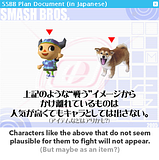1. The character should appeal to the general population. It means the character's fans would flock to the game and could make new fans out of non-fans who don't know much about the character and/or the series the character hails from. The character doesn't have to be very popular or very well-known to get in because the character will become very popular and very well-known once the character becomes playable anyway.
2. The character should be physically capable of fighting as a Smash Brother. It means the character should have arms to use for punching, picking up items, grabbing characters and ledges, and so on. If the character doesn't have arms or is unable to use arms, the character should have something to substitute for arms such as Ivysaur's vines. It also means the character should have legs to use for kicking, running, jumping, and so on. If the character doesn't have legs or is unable to use legs, the character should have something to substitute for legs such as R.O.B.'s base. Characters like Mr. Saturn, Tamagon, Slime, and Goomba are not physically capable of fighting as Smash Brothers.
3. The character should be from a character-driven series. I picked this one from the All-Star Mode update on the Dojo! site (look it up). Sakurai is interested in characters who are from character-driven series (read: core games), not casual games which is why Sakurai specifically mentioned Animal Crossing characters and Nintendogs as not suitable for fighting as Smash Brothers. Personally, I think the Mii could be the exception if the Mii is used for a "create-a-fighter" mode (it makes sense to me and it would fit the whole point of the Mii) but even that one seems unlikely since Sakurai basically (and accurately) grouped Wii Sports with the other casual games listed in the Dojo! site.
4. The character should be somehow different from the existing characters. It means the character should have identifying features and unique abilities. I think it is also okay to mix-and-match the existing moves to make new unique characters (as long as it suits the character) because many of the existing characters already have similar moves and characteristic traits and they are still considered unique anyway. The exceptions are the clones and semi-clones, obviously.
5. The character should be a major recurring character in their own series. I follow this hierarchy:
1. Playable mascot
2. Unplayable mascot
3. Playable protagonist
4. Unplayable protagonist
5. Protagonist's playable sidekick
6. Protagonist's unplayable sidekick
7. Playable villain
8. Unplayable villain
9. Villain's playable sidekick
10. Villain's unplayable sidekick
11. Playable one-time good character
12. Unplayable one-time good character
13. Playable one-time evil character
14. Unplayable one-time evil character
6. It is recommended that the character is internationally available than to be available in only one region. We only had three exceptions to this rule (Marth, Roy, and Lucas) so I think it is okay to bend this rule a couple times but don't add too many regionally exclusive characters. I think Sakurai gets around this rule by adding internationally available characters that are more popular in Japan than in the West (the only exception to this one, I think, was Sonic).
7. If the character is generic with many others who look exactly like this character, it is highly recommended that this generic character should be a major recurring character in their own series (see Rule 5). It is also highly recommended that this generic character is easily recognizable by fans and non-fans such as Yoshi, Pikachu, and R.O.B.
8. It is highly recommended that the character should have enough characteristic traits to set them apart from the existing characters. The character also shouldn't be a variation of an existing character. If they aren't any different from existing characters, they are very likely to end up as palette swaps, clones, semi-clones, or alternate costumes.


 )
)